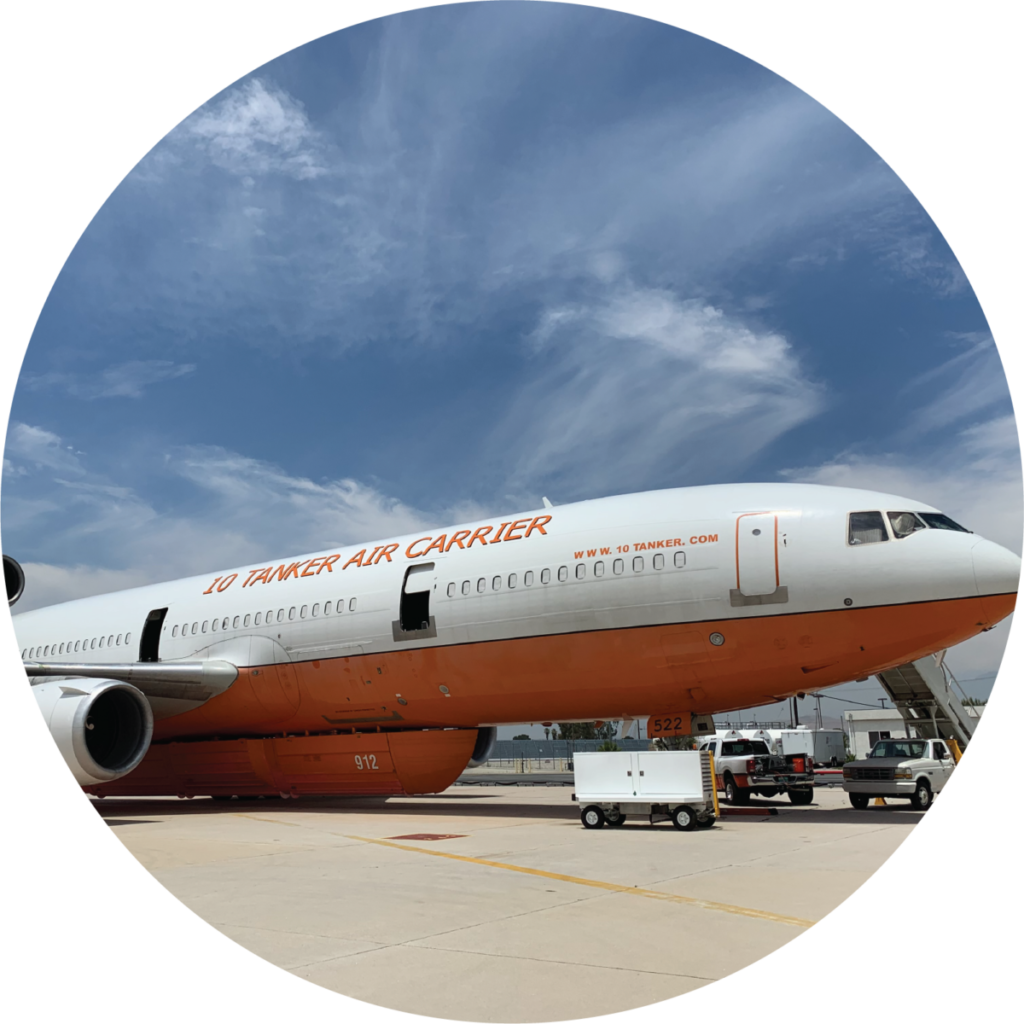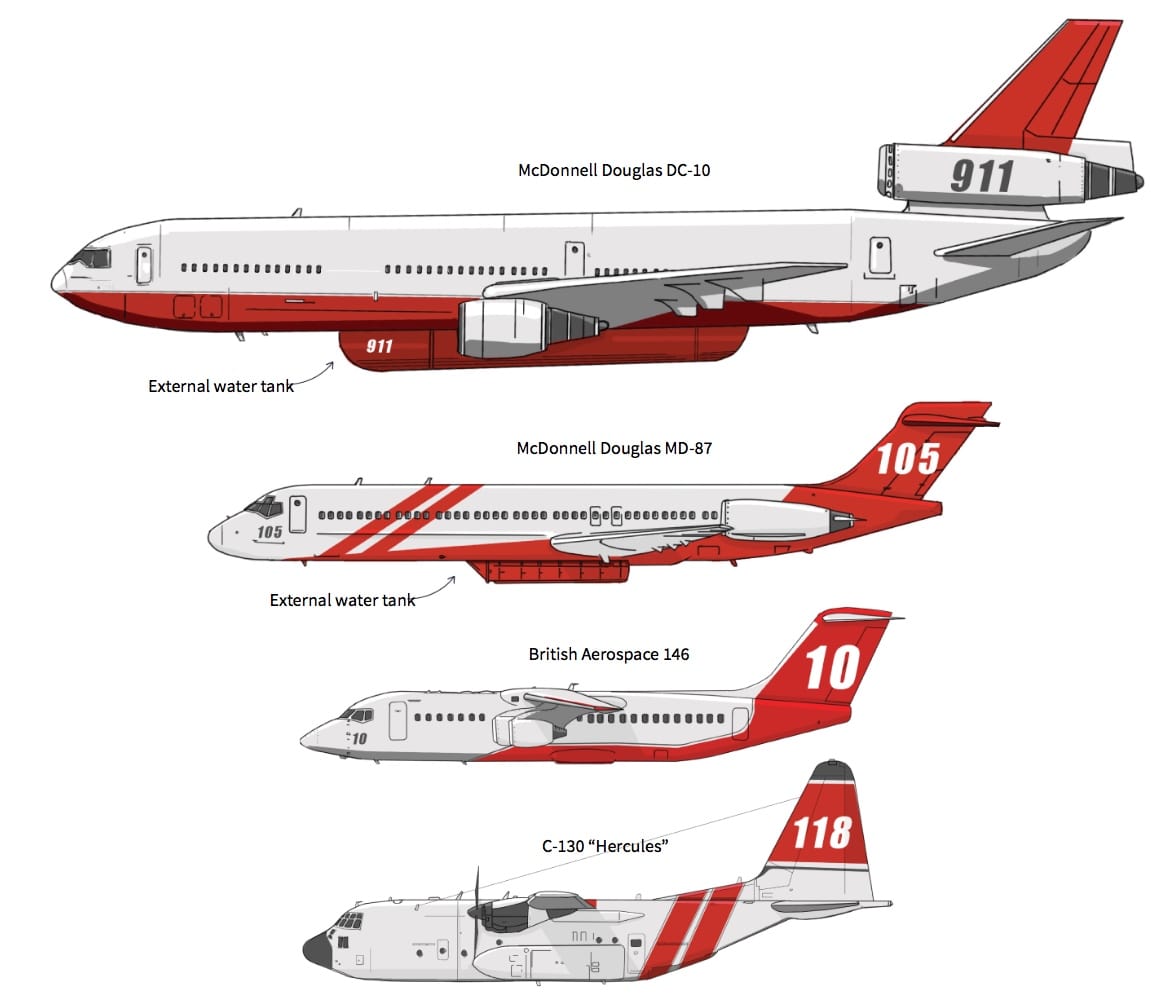Vlat Aircraft - As with other VLAT products, Joubert's project it touted to also have the capacity to carry vital firefighting products from site to site in addition to a full load of retardant, increasing the planned effectiveness of the aircraft, should it make it into final production, realizing
the full potential of the project for service both in Europe and overseas. Aerial firefighting involves the use of aircraft–both fixed-wing and rotary-wing–to combat wildfires. Among the fixed-wing type are air tankers and water bombers equipped with tanks that can be filled with fire retardant or water.
Vlat Aircraft

Some air tankers (like the DC-10 VLAT pictured below) are loaded on the ground at an air tanker base, while other aircraft (such as the Bombardier 145 "Superscooper") can be loaded by skimming water from lakes, reservoirs, or large
rivers. LATSs and VLATs also have their place in the wildfire response "tool kit". But they come with high costs and slower response times. Initial attack with a group of AT-802F SEATs can be more effective than larger air tankers and far more economical in many situations.
An AT-802F Fire Boss, for example, can deliver almost 1/2 the payload of a twin-turbine engine water scooper for about 1/10th of the capital cost and 1/5th of the operating cost. Aerial supervision modules, also known as lead planes, are typically the types of firefighting planes that head to the scene of a wildfire first.
Their job is to assess the area for the rest of their team. They also mark the areas where airtankers should dispense their fire retardants by releasing a plume of white smoke.13 In 2002, the company 10 Tanker Air Carrier began proof-of-concept testing of the DC-10 VLAT in an aerial firefighting role.

In 2006, the aircraft was issued a Supplemental Type airworthiness certificate by the FAA which allowed it to be modified for aerial firefighting. Shortly thereafter, the DC-10 VLAT was certified as an air tanker by the United States Forest Service and was first used in California during the 2006 wildfire season on a "call-when-needed" basis at the price of $26,500 per flight hour.
The Kios system invented by the pair is designed to be installed in the Airbus A330 airframe. According to the company "The interest of the project is not to replace existing firefighting equipment and modules but to provide additional assistance to public authorities" explains David Joubert.
Kepplair Evolution, while having lofty goals as a startup with big ambitions and in need of a large cash influx to accomplish their goals, has plans of being integrated into the rescUE European civil protection mechanism, to offer the European Union "long-term contracts or
one-off contracts to respond to emergencies". VLAT aircraft have had much success in the aerial firefighting industry, even with the retirement of the world's largest VLAT, the Global Supertanker, whose funding was pulled earlier in 2021. The former global supertanker was recently seen after its sale to National Airlines as a freight
carrier decked in a National logo just last week. Smokejumpers are firefighters who are specially trained to fight fires. The smokejumper aircraft drops 8-10 of them, as well as cargo, into areas where a wildfire is burning close by.

In some cases, this is the only means of transport to a wildfire, depending on where it's burning and if the roads leading to it are blocked.11 The Western Fire Chiefs Association is a division of the International Association of Fire Chiefs, and is a registered nonprofit, tax-exempt charitable organization under Section 501(c)(3) of the U.S.
Internal Revenue Code. Donations are tax-deductible as allowed by law. Large airtanker (LAT) planes, with their capacity for 2,000 to 4,000 gallons of fire-retardant, offer higher and more widespread coverage. This is helpful for putting out forest fires, as they can fly above the canopy.
However, their size can make it difficult to land and take off. 5 Air Tractor AT-802F aircraft are much less expensive to contract and operate than LATs and VLATs. Fire agencies can afford to deploy more of them.
This, in turn, improves the response time, effectiveness and reliability of initial response while expanding operations across a fire-prone region. Simply put, the AT-802F is purpose-built for efficient and cost-effective aerial firefighting. A water scooper is exactly what it sounds like;
a small plane that can hover over a body of water, such as a lake, and intake up to 1,600 gallons in a span of about 12 seconds. This allows it to refill its water reservoirs without having to circle back to a water station.

They fly low, no more than 150 ft above ground level, so that they can more accurately dispense water on specific areas to help keep the fire from spreading.9 Air attack planes are small, highly maneuverable planes that allow the leader of the air contingent of firefighters to get up close and personal with the wildfire.
From the vantage point of a Twin Commander 500 or 600, the Air Tactical Group Supervisor can choose access points to the wildfire for the units on the ground as well as decide where the air tankers should dispense fire retardant.15
The single-engine air tanker (SEAT) is the smallest of the firefighting planes. It is mostly used to put out hotspots – areas of land where a fire has either just started or is hot enough to blaze up at any moment.
Because of its small size, it only carries about 800 gallons of fire retardant. However, its size can also be an advantage, as it can easily land and take off on various types of terrain with very little runway.3
The idea of new VLAT technology development is far from over, however. Coulson Aviation has proven with the continuous growth of their 737 Fireliner aircraft. In a recent article published in French media, a new idea has been gaining traction in the European market.

That of a VLAT tanker aircraft based on the Airbus A330 airframe. This idea was initially floated by airline pilot David Joubert, who was inspired by VLAT development in the US and Canada. Forming a partnership with Dominique Legendre, a professor from the Toulouse Institute of Fluid Mechanics, the two formed Kepplair Evolution.
A company that has now been recognized with a patent for a retardant delivery system named Kios patented in 2019. Joubert also touted the economic stability of the project and the viability of bringing the aircraft to fruition, claiming that a used A330 will cost between 3 and 8 million euros (3.5 to 9.6 million USD) to purchase, and a conversion cost of between 15 and
20 million euros (17.75 to 23.68 million USD) to make it an operational firebombing aircraft. Joubert compared the cost of recent government Dash 8 water bombers in France costing a total of 400 million Euro (473.78 Million USD) or 66 million euros (78.17 Million USD) per aircraft
The DC-10 VLAT is a converted McDonnell Douglas DC-10 commercial airliner. It's a three-engine, wide-body aircraft that was first introduced in 1971 and was in service with American Airlines, Hawaiian Airlines, and Pan Am. Production of the DC-10 ended in 1989 and the aircraft flew its last commercial flight in February 2014.
The Kios system touts the capacity to drop more than 10,000 gallons (40,000 liters) of retardant which is four times that of traditional French tankers currently at work around the region that are capable of dropping a maximum of 2600 gallons (10,000 liters) deploying a swath

line over 1600 feet (500 meters) long and 130 feet (40 meters) wide. As with other VLAT aircraft, one of their main advantages is speed, to reach the scene of a fire in time to make a difference.
The Airbus A330 has a cruise speed of 542 knots. French media organization Le Figaro contacted the General Directorate of Civil Security and Crisis Management, who expressed some reservations about the use of airliners to fight forest fires.
Stating that the aircraft in question would seem "better suited to the fight against large established fires (California type, Siberia), without the presence of a ground component in contact with the fire". The DGSCGC also indicates that it is now favoring "airplanes with propeller engines, more suited to the geography of European areas of operation".
The smaller Canadair CL415 and DASH8 have, for example, a "capacity for rapid rotation between fire and refueling stations or scooping sites" specifies the DGSCGC. While the European Union may still be gun shy of such a lofty target, the international need for more VLAT's has already been demonstrated over recent years where overlapping international fire needs stretched internationally available resources to their limits.
Single Engine Air Tankers can be en route to a fire faster than LAT and VLAT aircraft, which is a critical capability for containing fires while they are still small. A group of AT-802F SEATs can be loaded and dispatched from small, regional airports which are often closer to fires in the wildland urban interface.
Once over the fire, AT-802F aircraft can drop water, gel or fire retardant to control the situation until fire crews arrive. The company hopes to be able to put the first aircraft into service before the 2024 Olympic Games, allowing the aircraft to be on standby for any wildfire threat that may jeopardize the games.
As a long term goal, Joubert aims to transform seven planes in total, hoping that the global need for VLAT aircraft increases The DC-10 VLAT is not used on all fires as it is operationally limited due to its time to reload retardant and refuel at air tanker bases.
However, one retardant drop from the DC-10 covers a swath roughly 300 feet wide and one mile in length, four times the coverage of any other tanker currently in use. Very large airtankers (VLATs) are extremely useful for dousing vast swaths of landscape in fire retardant.
These planes are designed to hold over 8,000 gallons and dispense at 250 ft above the ground or a forest canopy. The Boeing 747 Supertanker can hold up to 24,000 gallons.7